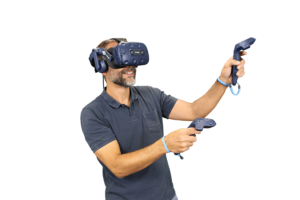Virtual Reality in Physiotherapy: For whom? For what?
The recent emergence of Virtual Reality (VR) in physiotherapy rightly raises questions about the benefits of this technology for our patients.
It has been used for several decades for training and learning, particularly thanks to simulators, because learning can be transposed and sustained in a physical world [1] [2].
What about the learning and retraining of our patients?

Studies have shown the superiority of VR over conventional training in some complex gesture learning, and also in learning gesture adaptation or dual-task activities [3] [4] [5]. Gesture repetition is more precise and reproducible thanks to tracking.
VR offers a wide variety of exercises in the three planes of space, which can be analytical or complex. It allows the patient to have a visual feedback on the gestural realization: he is warned when a compensation is set up. Thus, during a lateral inflection exercise, the patient will be warned if he adds flexion or extension to his movement. Similarly, for a shoulder abduction exercise, the VR will alert the patient to flexion compensation during abduction.
Studies on the benefit of VR in post-stroke patients show a 30% reduction in the Timed Up and Go test in patients who received rehabilitation with VR exercises compared to conventional rehabilitation with the same exercises [6] [7] [8].
Moreover, the physiotherapist will be able to dissociate specifically a sensory input involved in the balancing reactions. In a sports patient, the practitioner will be able to use virtual reality to analyse whether a deficit in a balancing reaction is caused by a somaesthetic, visual or vestibular deficit, or a deficit in muscle strength.

Kinesiophobia is also an excellent indication for virtual reality work. The patient's attention is diverted from the task at hand (perceived as potentially painful) to the success of the "game". Work in the context of pain acceptance in patients with phantom limb pain or CRPS also highlights the beneficial contribution of VR-induced sensory isolation. [9] [10]
The practitioner can eliminate the patient's failures in the rehabilitation exercises. The more the practitioner is able to adapt the virtual environment in real time without interrupting the immersive experience, the more impact it will have on neural plasticity. The more positive the gestural experience, the faster the brain will learn.
The VR is a complete tool that allows assessments to be carried out, as well as rehabilitation exercises for numerous pathologies of the upper and lower limbs and also the spine. The reduced space required for a set-up that allows a patient to work sitting and standing is also noteworthy. It is also possible to move a patient in a larger space and even to perform jumps.
In conclusion, as in many fields, VR is settling in Functional Rehabilitation in a sustainable way and will quickly become an essential tool to reinforce the therapeutic arsenal of the physiotherapist.
Bibliographic reference
[1] Training in virtual environments: Transfer to real world tasks and equivalence to real task training. F D Rose, E A Attree, B M Brooks, D M PArslow, P R Penn, N Ambihaipahan DOI: 10.1080/001401300184378
[2] Virtual Environments for Motor Rehabilitation: Review MAUREEN K. HOLDEN, Ph.D. CYBERPSYCHOLOGY & BEHAVIOR Volume 8, Number 3, 2005
[3] Augmented Feedback Presented in a virtual Environment Accelerates Learning of a Difficult Motor Task. E Todorov, R Shadmehr, E Bizzi. Journal of Motor Behaviour, 1997, Vol. 29, N°2, 147-158
[4] Effects of physical randomness training on virtual and laboratory golf putting performance in novices. T C Pataky 1, P F Lamb 2 Sports Performance 8 Oct 2017 DOI: 10.1080/02640414.2017.1378493
[5]Learning and transfer of complex motor skills in virtual reality: a perspective review. Danielle E Levac 1, Meghan E Huber 2, Dagmar Sternad .DOI: 10.1186/s12984-019-0587-8
[6] Rehabilitation that incorporates virtual reality is more effective than standardrehabilitation for improving walking speed, balance and mobility after stroke a systematic review Davide Corbetta 1, Federico Imeri 2, Roberto Gatti 3 j.jphys.2015.05.017. Epub 2015 Jun 18 DOI: 10.1016/j.jphys.2015.05.017
[7]Gait and balance training using virtual reality is more effective for improving gait and balance ability after stroke than conventional training without virtual reality. Journal of Physiotherapy 63 (2017) 114 doi.org/10.1016/j.jphys.2017.02.010 doi.org/10.1016/j.jphys.2017.02.009
[8] Feasibility and Effectiveness of Virtual Reality Training on Balance and Gait Recovery Early after Stroke: A Pilot Study. de Rooij et al, Int J Phys Med Rehabil 2017, 5:4 DOI: 10.4172/2329-9096.1000418
[9] Immersive Virtual Reality and Virtual Embodiment for Pain Relief Marta Matamala-Gomez1,2*, Tony Donegan3, Sara Bottiroli4,5, Giorgio Sandrini1,2, Maria V. Sanchez-Vives3,6,7† and Cristina Tassorelli1,2†Front. Hum. Neurosci., 21 August 2019 https://doi.org/10.3389/fnhum.2019.00279
[10] Faure C, Limballe A and Kerhervé H (2019) Fooling the Brain, Fooling the Pain: The Role of Mirror Therapy and Modern Uses in Virtual Reality. Front. Young Minds. 7:91. doi: 10.3389/frym.2019.00091

